- Joined
- 27 December 2005
- Messages
- 17,691
- Reaction score
- 25,943
I'm not certain but I think one of those photographs were in Bill Gunston's book "All the Worlds Rockets and Missiles".Northrop-Motorola AMRAAM
The AMRAAM requirement was established by a Joint Service Operational Requirement ( JSOR ) dated September 1976. Following a DSARC decision in November 1978 to approve program initiation, five contractors submitted prototype proposals. In February 1979, the Air Force awarded validation contracts to Hughes Aircraft Company, also the primary contractor for the AIM- 54 PHOENIX missile, and to Raytheon, the primary contractor for the AIM-7SPARROW and AIM- 9 SIDEWINDER missiles, to develop a complete systems design approach, and to build and test prototype missiles to demonstrate the AMRAAM concept. The effort included missile test firing and demonstration of air vehicle and air vehicle subsystem functions.
three prospective contractors have been pursuing exploratory development of critical technologies using both government and company funds, while two hopefuls have been working entirely with corporate funds. General Dynamics, Hughes and Northrop have received government funding, while Ford Aerospace and Raytheon have operated with corporate funds.
Source: AWST 13th March 1978 P.167-168In anticipation of the requirement for an active radar-guided air-to-air missile, Motorola‘s Government Electronics Div. initiated company-funded studies, which resulted in a modest follow-on contract from the Naval Air Systems Command in 1971. Motorola subsequently built a breadboard model that was evaluated in captive flight tests in a joint Navy/USAF effort. An improved model, operating at a different frequency and at higher power level was tested in 1975, with good,results.
More recently, Motorola has delivered a brassboard model of the now tri-service guidance unit, designed to fit into a 5-in dia. missile frame, which will be evaluated at the Naval Weapons Center (AW&ST Jan. 16, p. 57). Motorola is a member of the Northrop team that will bid for the new joint-service missile.
Another Contender
Hughes Aircraft, whose experience in all-weather air-to-air missiles goes back to the first weapon of this type ever mass produced in the U. S., the semi-actively guided Falcon, is considered another strong contender. The company has provided little information on its technical approach except to disclose that its missile radar will employ solid-state Impatt diodes to generate microwave energy, using a company patented power-combiner. Failure of one or more diodes in the combiner simply results in a reduction in power rather than complete failure

The radar is expected to employ a programmable digital signal processor, using technology developed by Hughes for use in its new radar for the F-18/A-18 (AW&ST Jan. 16, p. 55). The thin, plastic radar antenna will be driven for scanning by torque motor—type actuators.
International Team
Ford Aerospace has teamed with Britain‘s Marconi-Elliott and EMl, Ltd.. for the guidance portion of its entry. Marconi-Elliott developed the effective monopulse radar semi-active guidance head for the British Skyflash air-to—air missile.
USAF is hoping to obtain congressional approval to reprogram funds to fill the Fiscal 1978 void in funding for the new air-to-air missile program. if Congress approves, modest study contracts will be awarded to the five contenders. The present timetable. assuming that advanced development is approved this fall by the Defense Systems Acquisition Review Council, is to select two contractors late this year for a 33—month effort, leading to a fly-off/shoot-off in late 1981.
AWST 14 Feb 1977New Radar-Guided Weapon Under Study
By Barry Miller
Los Angeles—Next-generation Air Force and Navy air-to-air radar-guided missile intended to supplant the Raytheon Sparrow AIM-7F as the medium-range, all-weather armament for new fighters will move into a competitive three-year advanced development late this year.
The weapon is earmarked for four high-performance fighters—USAF’s McDonnell Douglas F-15 and General Dynamics F-16 and the Navy/Grumman F-14 and McDonnell Douglas F-18. A sizable foreign market also is foreseen, particularly among North Atlantic Treaty Organization F-16 customers, but possibly for the Northrop F-18L and F-5 fighters as well, depending on how certain technical features evolve during development.
Five companies are running initial studies of the advanced medium-range air-to-air missile (AW&ST Sept. 20, 1976, p. 9) under contract to what has recently
become a joint Air Force-Navy system program office at USAF’s Armament Development and Test Center at Eglin AFB, Fla. Three of the five—General Dynamics/Pomona, Hughes Aircraft and Northrop—are working with contracts of about $900,000 each; the remaining companies, Raytheon and Ford Aerospace & Communications, are unfunded contractors.
The program office anticipates releasing proposal requests late in the spring for a three-year prototype phase leading to a competitive flyoff between two contractors. An Air Force official indicated the two prototype contractors will be selected late in the summer.
The selection will be narrowed to one contractor for engineering development and a production start on the weapon in the mid-1980s.
The advanced medium-range air-to-air missile (AMRAAM) will incorporate a number of technical advances intended to provide users with a “‘fire-and-forget” capability, at least at short ranges. This will free launching aircraft from the need to illuminate targets through intercept, as they must now do with the semiactively guided Sparrow missile. The fire-and-forget feature is the product of using an active radar seeker, conceptually similar to the terminal seeker in the much larger Hughes Phoenix missile. Squeezing the active seeker into a small missile airframe of the size anticipated, perhaps no larger than the characteristic 5-in.-dia. of a Sidewinder, is a key technological advance. Its feasibility may hinge on the availability of compact, solid-state power sources that are strong enough to yield a 3-5-mi. terminal range.
An active terminal guidance seeker solves the otherwise difficult problem of interfacing the weapon with four radars of different pulse repetition rates in the four aircraft candidates to use missiles. The different pulse rates would complicate accommodation of the weapon if it were semi-actively guided.
The “‘fire-and-forget” performance lessens the chance that a target will become aware that it is under missile guidance illumination and frees the firing aircraft to search for other threats. It also poses the prospect of relieving future aircraft of the need to have or use forward-looking radars for missile attack. The attacking aircraft might be able to acquire targets visually (much as they were required to do with Sparrow in Southeast Asia) and fire the weapons without emitting their own radar energy or might acquire targets based on threat signal emissions using an onboard passive radar homing and warning system.
By having an essentially quiet weapon concept, in which signal emission from the launching platform is minimized or eliminated, the services would minimize the likelihood of the aircraft weapon control system suffering disruption by hostile jamming.
The contractors for the missile are considering a midcourse guidance system sufficiently accurate to bring the weapon to within the approximate volume where the terminal seeker could take control. Most of them are concentrating on strapdown inertial platforms that can be updated through midcourse by radio commands.
The launching aircraft would be able to have several missiles in the air at one time because the weapons will be autonomous or nearly autonomous after launch. This multiple target capability would give the smaller, less-complex new missile much of the same kind of multiple-shot capability that the Phoenix achieves with the F-14 track-while-scan AWG-9 radar.
While the exact size of the new missile is still undecided, studies are focusing on a weapon roughly half the size and weight of the Sparrow AIM-7F but with a comparable range and a few performance features akin to those of Phoenix. The latter would include the active terminal homing and multiple target capability.
“The AMRAAM missile will be a poor man’s Phoenix,” one observer commented. The cost of this weapon, the program office hopes, will be about half that of the Sparrow.
Of the four aircraft candidates for the new missiles, the F-16 appears to offer the main size constraint. The aircraft is not now equipped nor intended to control Sparrow launches. If it were equipped with Sparrow, the fighter would suffer a noticeable performance degradation amounting to a 10-15% penalty in aerodynamicperformance and time to accelerate.
A radar-guided missile would be important armament for the F-16 in a European environment where weather so frequently precludes use of visual weapons.
European Advances
Entrants in the missile competition are attempting to tap advances made in air-to-air missile technology by West European companies. Marconi Space and Defense Systems, Ltd., is Ford Aerospace’s radar guidance subcontractor for the effort, and the British EMI, Ltd., is one of several companies Ford is considering as its fuzing contractor. Marconi made the monopulse seeker for the United Kingdom Skyflash modification to the Sparrow AIM-7E, which has demonstrated what is widely regarded as a remarkable success in tryouts at the Pacific Missile Test Center. Skyflash has scored 11 hits in 12 firings,
six of which were contact hits, demonstrating the reduced miss distance capability of the monopulse seeker. The latter type of seeker provides look down, shootdown performance against low-flying targets, and competitors on the new missile are expected to include monopulse features in their active seekers.
Northrop has a license agreement with Engins Matra under which it will obtain aerodynamic and control data relating to the French company’s Magic 550 missile for incorporation in the new U.S. missile. The French missile, Northrop believes, has greater maneuverability and presents less drag than comparably sized missiles like Sidewinder. It also has an autopilot. The Magic achieves its maneuverability with an extra group of four fixed control surfaces ahead of the movable control canards in the forward portion of the missile. The combination of the two smooths flight at high angles of attack. The weapon has a spin free tail, with each of four tail surfaces hinged on a bearing, which avoids imparting any rolling moment to the missile.
Northrop is teamed in its effort with Motorola, whose active solid-state seeker work on what is called a fast acquisition search and track (Fast) seeker has led to a $7.2-million tri-service development contract. Under this contract, Motorola is building five active radar seekers, packaged in both 8-in.-dia. and the Sidewinder 5-in. dia. versions. Some of the service interest in the Motorola seeker is as a possible replacement for the Sidewinder infrared seeker.
As applied to the new missiles, the Motorola sensor is expected to reduce the wandering of the missile’s aim point, which occurs at short distances from the target as the phase front returns from its radar signals combine. Reducing the aimpoint error or miss distance would permit use of smaller warheads, hence result in a smaller missile. The seeker uses an Impatt diode power source. There is a possibility the fuzing function could be handled by the seeker instead of requiring a separate unit.
Northrop’s design approach also would incorporate a strapdown inertial platform developed by Northrop’s Precision Products Dept. and now in test at the Naval Weapons Center. The sensor developed for possible application in the Chaparral air defense missile system meets the Sidewinder 5-in. envelope objective. The three-gyro, three-accelerometer package with small digital computer resolves sensor outputs into a proper coordinate system. The platform can accept command inputs over a one-way radio link.
The new missile is expected to be entirely digital, using a reprogrammable processor for both midcourse and terminal guidance calculations. These processors are smaller, more flexible and more reliable than analog equivalents previously used in small tactical missiles. They also have important cost implications: equipment can be modified more readily during the missile’s operational lifetime, and changes can be made during engineering development by altering software.
A digital guidance seeker offers an additional bonus in its ability to implement increasingly sophisticated guidance laws. With range, range-rate, angle and angle-rate data available, the seeker’s computer could obtain target acceleration data from the derivatives of the rate information, provided the signals are clean.Since the missile computer knows its own acceleration, based on the platform’s information, it could determine exactly what the target is doing.
During current studies, the five contractors have to perform tradeoff studies and prepare cost and performance estimates. They must conduct guidance hardware experiments and deliver seekers to Holloman AFB, N. M., by May for testing. The contractors are now working to a draft joint services operational requirement prepared after the studies got under way originally as a lightweight radar missile with backing from the Defense Advanced Research Projects Agency.
Aerodynamic vehicle used for evaluation by Northrop in the USAF/Navy joint advanced medium-range air-to-air missile program (AMRAAM) is launched from a ground site. The vehicle is one of several studied by Northrop, one of five contractors in the study effort. Objective of the program is to develop an active-guided fire-and-forget missile for new fighters—the Grumman F-14, McDonnell Douglas F-15, General Dynamics F-16 and the McDonnell Douglas/Northrop F-18.
Missile Guidance Proposals Sought
Air Force and Navy plan to issue in mid-June a request for proposal to industry for competitive prototyping of a guidance section for the joint-service advanced medium-range air-to-air missile (AMRAAM) for the Grumman F-14, McDonnell Douglas F-15, General Dynamics F-16 and Northrop/McDonnell Douglas F-18 fighters.
The services planned to issue the proposal request this week but had to delay because a reciprocal defense procurement memorandum of understanding has not been signed with the United Kingdom.
Great Britain’s Marconi Space and Defense Systems, Ltd., is teamed with Ford Aerospace & Communications to provide the entrant for the companies’ seeker design for the advanced missile. Without the memorandum of understanding being signed, the Ford-Marconi team could not enter the competition, so the request date has been delayed.
Other competitors for the new seeker include:
= Hughes Aircraft.
= Raytheon.
= General Dynamics.
= Northrop/Motorola.
Hughes Aircraft last week was discussing with Marconi possible use of Marconi technology or hardware components in the active terminal guidance seeker for the Hughes design in the advanced missile development program.
All of the five companies now entered in the design definition phase for the advanced missile’s seeker have focused their designs on an active inverse monopulse technique. Only two will be chosen for prototyping.
The advanced medium-range air-to-air missile program is intended to develop a replacement for the present Navy/Raytheon AIM-7F Sparrow in the late 1980s (Awast Feb. 14, p. 42). Two of the seeker competitors in the advanced missile program— Raytheon and General Dynamics—also are competitors in the program to produce a semi-active inverse monopulse seeker for the AIM-7F now in the inventory to enhance its capability to operate in an electronic countermeasures environment.
A Marconi inverse monopulse seeker developed for the Hawker Siddeley XJ-521 Skyflash air-to-air missile, which has already undergone some testing in the U.S. by the Navy at Pt. Mugu, Calif., will be continued in live firing trials if it is successful in electronic countermeasure tests.
The Marconi seeker is being tested concurrently with competitive seekers built by Raytheon and General Dynamics in an electronics countermeasures test facility, under terms of a U. S.-British memorandum of understanding negotiated through the U. S. Defense Directorate of Research and Engineering. This program envisions live firing trials with a limited number of Skyflash missiles after the ECM studies are completed. The trials were to involve about two dozen missiles out of a planned procurement order for about 500, with the balance being purchased by USAF for operational use and evaluation on the McDonnell Douglas F-4.
However, USAF changed its mind and refused to purchase the 500 missiles after the British government decided not to stay in the North Atlantic Treaty Organization’s airborne warning and control system (AWACS) program (Aw&st Apr. 11, p. 15). However, ECM facility testing of the three seekers will
continue as planned.
In the XJ-521 tests already conducted by the Navy, the targets have been augmented with radar signature equipment and have all been at the same altitude as the McDonnell Douglas F-4 launch aircraft, or at a look-up angle, Defense officials said. The only target not augmented for the tests has been a drone T-33 aircraft, a large-radar signature target, according to U.S. officials. The two prototype advanced inverse monopulse seeker systems Raytheon and General Dynamics—use digital processing equipment for guidance, providing a capability for software programming to overcome electronic countermeasures as the threat increases in the future, according to officials.
The Advanced Medium Range Air-to-Air Missile (AMRAAM) was influenced by the DARPA LightWeight Radar Missile (LWRM) program in the early 1970s when DARPA initiated the program based on a tri-service technology base program in solid state radar. Both DARPA and the Air Force funded the original studies and limited technology development work. DARPA studies showed that a high speed, countermeasures-resistant, launch and leave, active radar missile with significant performance would not fit into the AIM-9 Sidewinder missile size and weight, which was DARPA's desire. The Air Force was willing to accept a larger size consistent with the AIM-7 Sparrow missile launch stations, and the program proceeded on that basis. The AMRAAM is a new generation missile and became the follow-onto the AIM-7 Sparrow missile series. It is faster, lighter, and has an improved low-altitude target capability. The AMRAAM began its conceptual phase in 1979 when the U.S. Air Force selected two of five competing contractors to continue into the validation phase. The validation phase ended in December 1981 , and the full scale missile was deployed in late 1991. With an inertial midcourse guidance and an active radar terminal guidance, the $400,000 missile can operate at ranges greater than twenty miles.
Lightweight Radar Missile Prototype.
The House deleted the request of $5.0 million because it did not intend initiation of a lengthy, high technology program.
The Air Force believes this is the "new, simple, reliable, all weather, air-to-air missile for Navy and Air Force use" recommended by the committee. The Lightweight Radar Missile (LWRM) Prototype Program is a joint Air Force Defense Advanced Research Projects Agency (DARPA) effort initiated with DARPA funds in N 1976. The objective of the LWRM Prototype Program is to demonstrate the feasibility of an effective, all weather missile at substantially lower cost than current radar missiles; it will be applicable to the F-15, F-14, F-16, F-18 and follow-on fighters. THis P.roq;am has the Qotential to fill the combined Air Force/Navy radar missile[WBM]requirement in the mid-1980s. This proposed redcution will prevent the Air Force from providing its agreed share ($1.5 million) of this joint effort necessary to Declassified lAW E012958 Ch WHS Records And Declassification Div complete Phase I of the program and will result in a 1-year program slip, plus cost increases associated with program restart (approximately $3.0 million). The remaining $3.5 million in FY 1977 is required to continue the program into the desired inter-operability design for Air Force/Navy fighter aircraft, fabrication and prototype performance competition and demonstration. Full restoration to the President's Budget amount of $5.0 million is requested.
Nothing formal that I know of. The Family Of Missiles MOA gave it the AMRAAM name pretty early and that's all anyone official called it until "Slammer" came along. DoD has only gotten more acronym-happy over time.I know that the AIM-120's name is the AMRAAM but it just occurred to me were there any proposed names for it during its development (For example how the AIM-9 is the Sidewinder, the AIM-7 is the Sparrow and the AIM-64 was the Phoenix)?
and that's all anyone official called it until "Slammer" came along.
More likely, the seeker is for the cancelled active radar version of Seawolf, which had a similarly blunt nose, presumably to limit the overall length of the missile.This advanced anti-air radar seeker from a GEC Review article from 1985 gives possible clues to the design of the Marconi AMRAAM seeker. Its notably using a twist-cassegrain antenna.
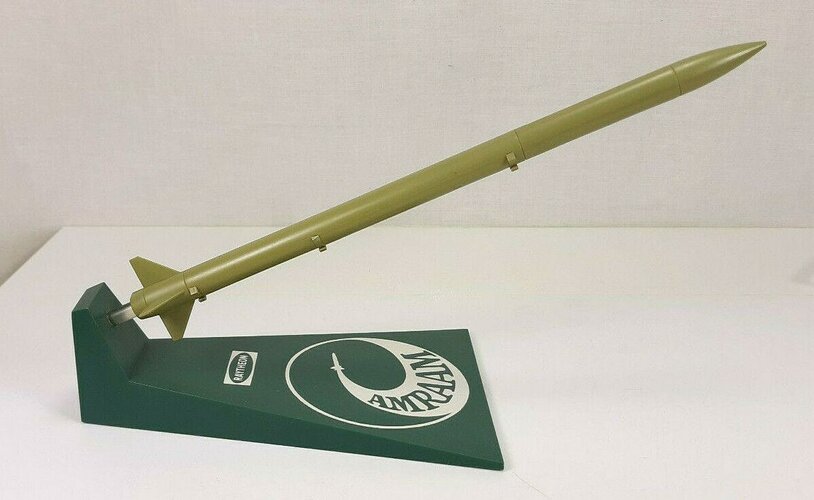
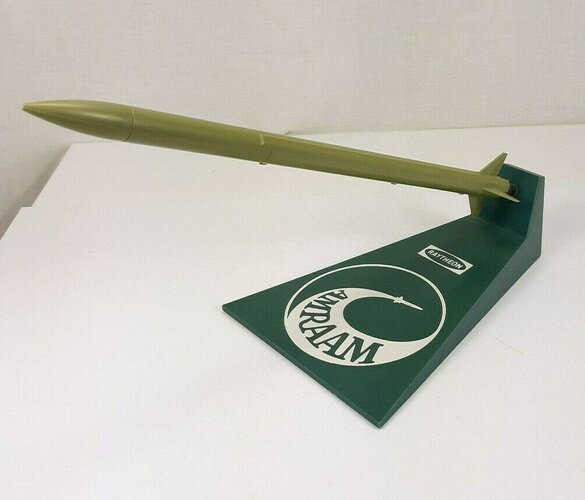


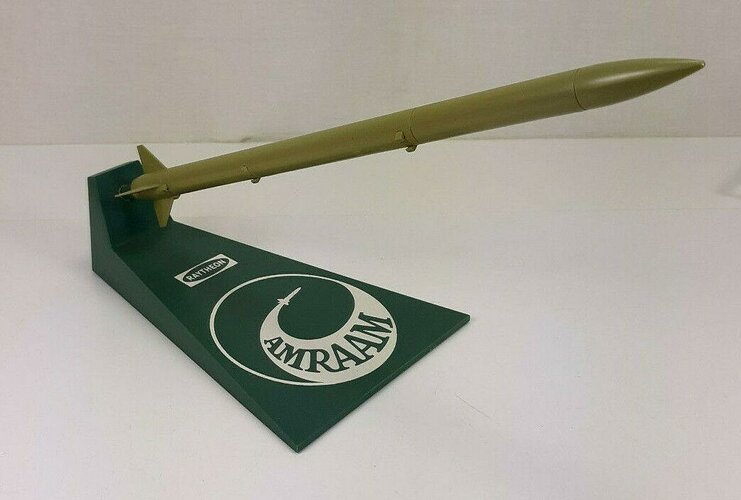
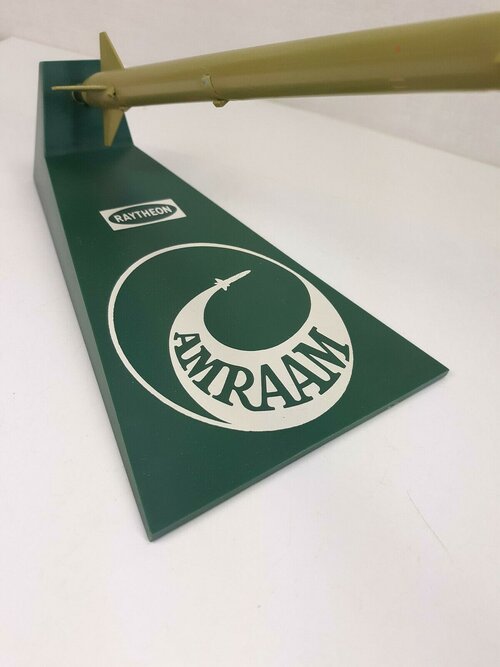
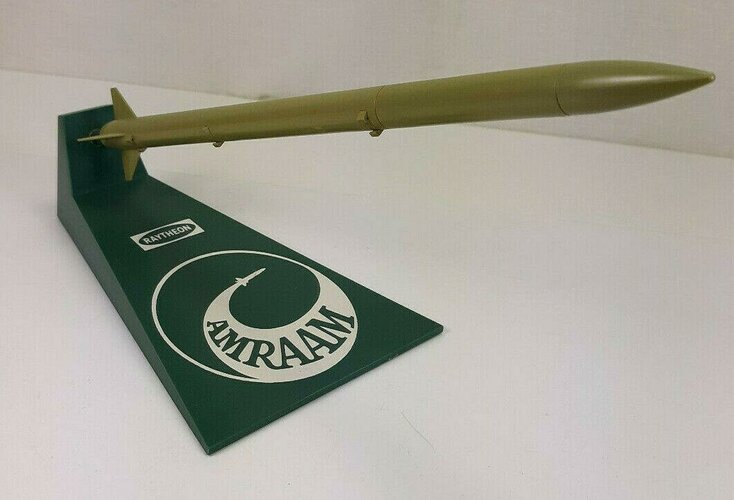
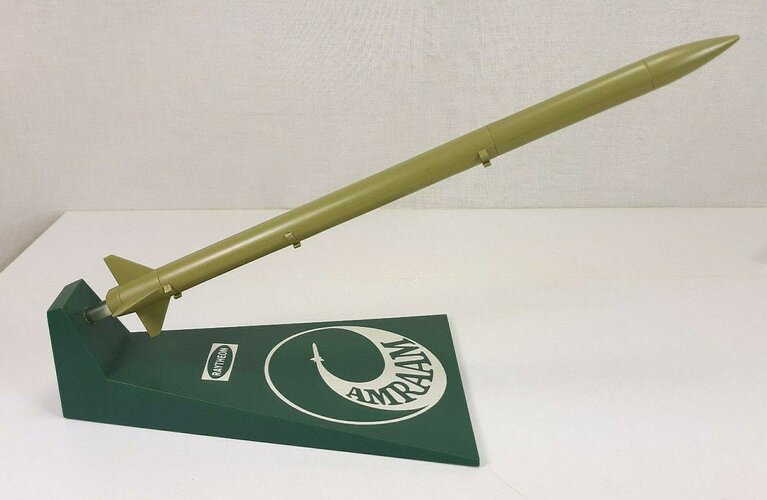
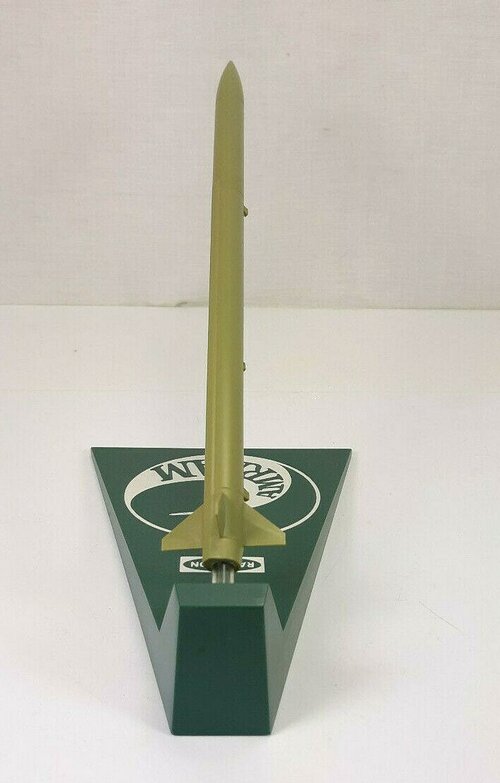
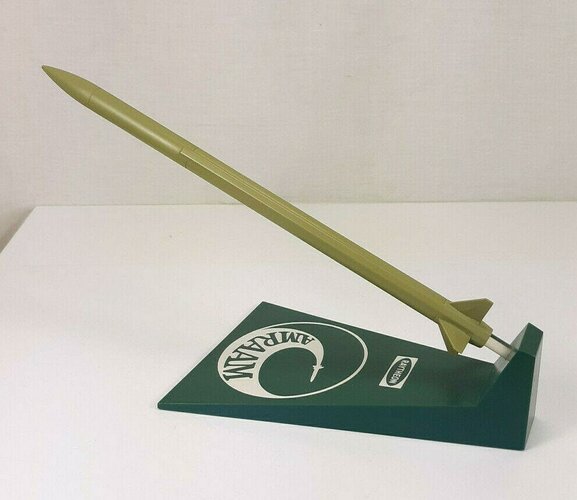
Found some wind tunnel prototype fins for 120A/B in a scrapyard in CA.
Note strain gauge remnant on left unit.
View attachment 748013
Yeah absolutely not, these are in my collection with a 120C rear fin.If you're not keeping them those fins could make you a tidy sum of money if you sold them on e-bay.
Yeah absolutely not, these are in my collection with a 120C rear fin.
Gonna CAD model them and then do FEA/CFD on these.
finite element analysis, basically looking at flutter moments etcFair enough.
CFD I assume is computational fluid dynamics but was is FEA?
